InterviewSolution
This section includes InterviewSolutions, each offering curated multiple-choice questions to sharpen your knowledge and support exam preparation. Choose a topic below to get started.
| 88951. |
A liquid hydrocarbon can be converted to gaseous hydrocarbon by |
|
Answer» Cracking |
|
| 88952. |
A hydrocation (A) (C_(8) H_(10)) (E) is a stream volatile compound and on nitrationgives two mononitro derivatives. (A) gives the followingreactions. The name of (H) is: |
|
Answer» Dibenzocylobutane `4 D.U`. and `C:H = 1:1` suggst that `(A)` contains benzene RING with two extra `C` atom [i.e., two `(Me)` groups]. Since compound`(A)` is steam volatie and on NITRATION GIVES two nitro-derivaties, so `(A)` is ortho-xylene. 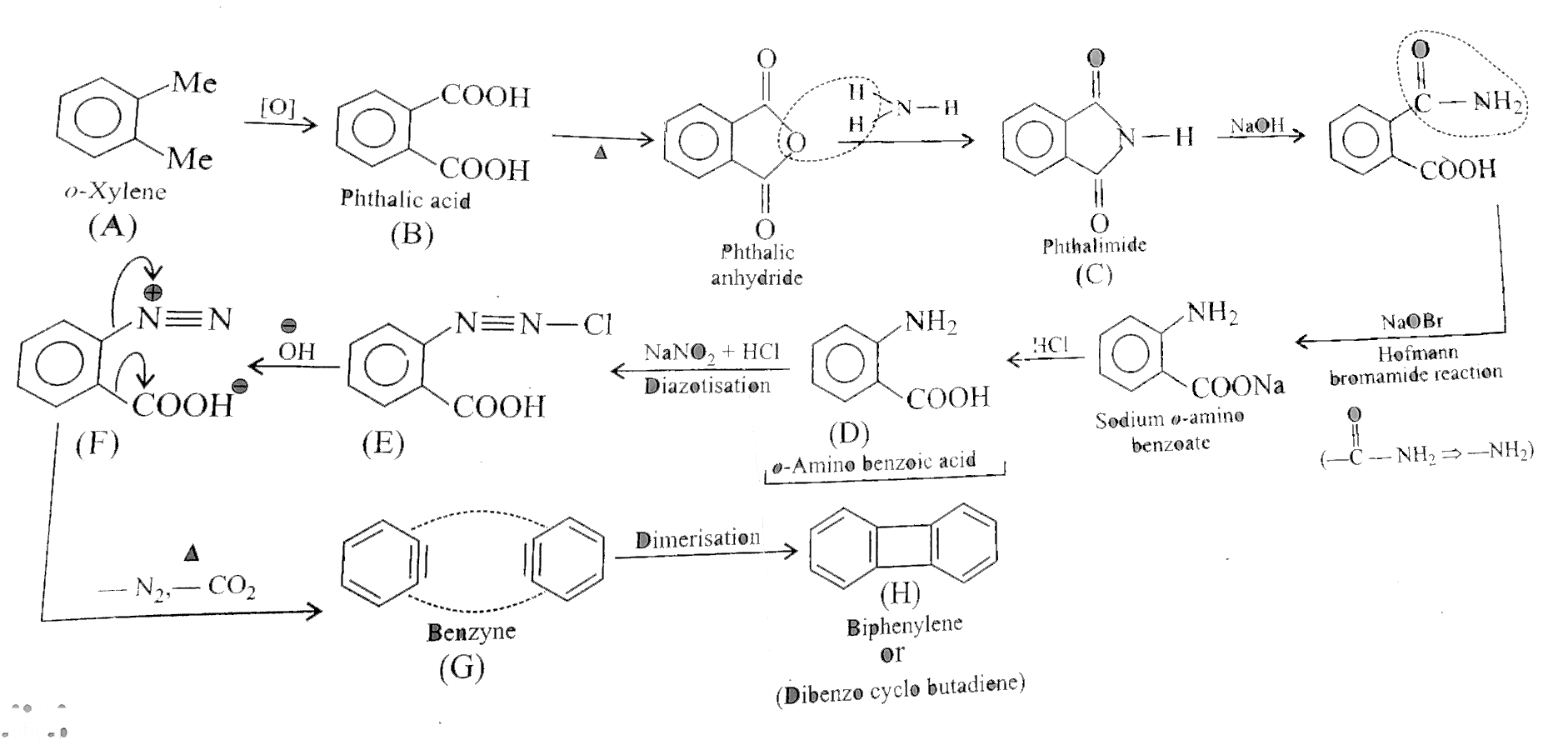
|
|
| 88953. |
(A) Liquid helium is used in NMR spectrometers and MRI systems(R) Liquid helium can be used in making powerful super conducting magnets |
|
Answer» Both (A) and (R) are true and (R) is the correct explanation of (A) |
|
| 88954. |
(A) Liquid helium can be used as a cryogenic liquid(R) Liquid helium can produce a very low temperatures of around 4.2k |
|
Answer» Both (A) and (R) are TRUE and (R) is the CORRECT EXPLANATION of (A) |
|
| 88955. |
A hydrocarbon (X) with vapour density = 27 containing C = 88.88% decolourizes KMnO_(4) and Br_(2) water without evolving HBr. It gave no ppt. with ethereal ammonical AgNO_(3) or Cu_(2)CI_(2) When reacted with dil. H_(2)SO_(4) in the presence of mercuric sulphate, methyl ethyl ketone (Y) is formed. The compound is |
|
Answer» `C_(8)H_(12)` |
|
| 88956. |
A liquid has vapour pressure 35xx10^(3)Nm^(-2) at 298 K. If the solution contains 0.2 mole fraction of a solute, the vapour pressure of the solution will be |
|
Answer» `2.8xx10^(3)NM^(-2)` |
|
| 88957. |
A hydrocarbon (X) reacts with Cl_2 giving the substitution product (Y). By the Wurtz reaction 'Y' yields a gaseous hydrocarbon, 'Z' having vapour density = 14. Identify X. |
|
Answer» `CH_4` `implies` MOLECULAR mass of the hydrocarbon (Z) = `2 xx 14 = 28` . Hence the hydrocarbon is ethane `(C_2 H_6)` . It can be obtained from METHYL chloride by Wurtz reaction , so the substitution product .Y. is `CH_3 - Cl` and the hydrocarbon .X. is `CH_4` (methane). `underset("(X)")(CH_(4)) overset(Cl_(2)) (to) CH_(3) underset("(Y)") (C)l overset("Na/ether")("Wurtz reaction") (to) CH_(3) underset("(Z)")(-)CH_3` |
|
| 88958. |
A liquid freezes at 300K and boils at 400K. If Kf and Kb values for the liquid are 5 and 2.5 ^(@)C/molalrespectively, then the ratio of latent heat of vaporisation to latent heat of fusion is :- |
|
Answer» `1:1` |
|
| 88959. |
A hydrocarbon (X) of the formula C_6H_12 does not react withbromine water but reacts with bromine in presence of light,forming compound (Y).Compound (Y) on treatment with Alc. KOH gives compound (Z) which on ozonolysis gives (T) reduces Tollens reagent which gives compound (W) after acidification . (W) gives iodoform test and after acidification produce compound (U) which when heated with P_2O_5 forms a cyclic anhydride (V). Compound 'x' is |
|
Answer»
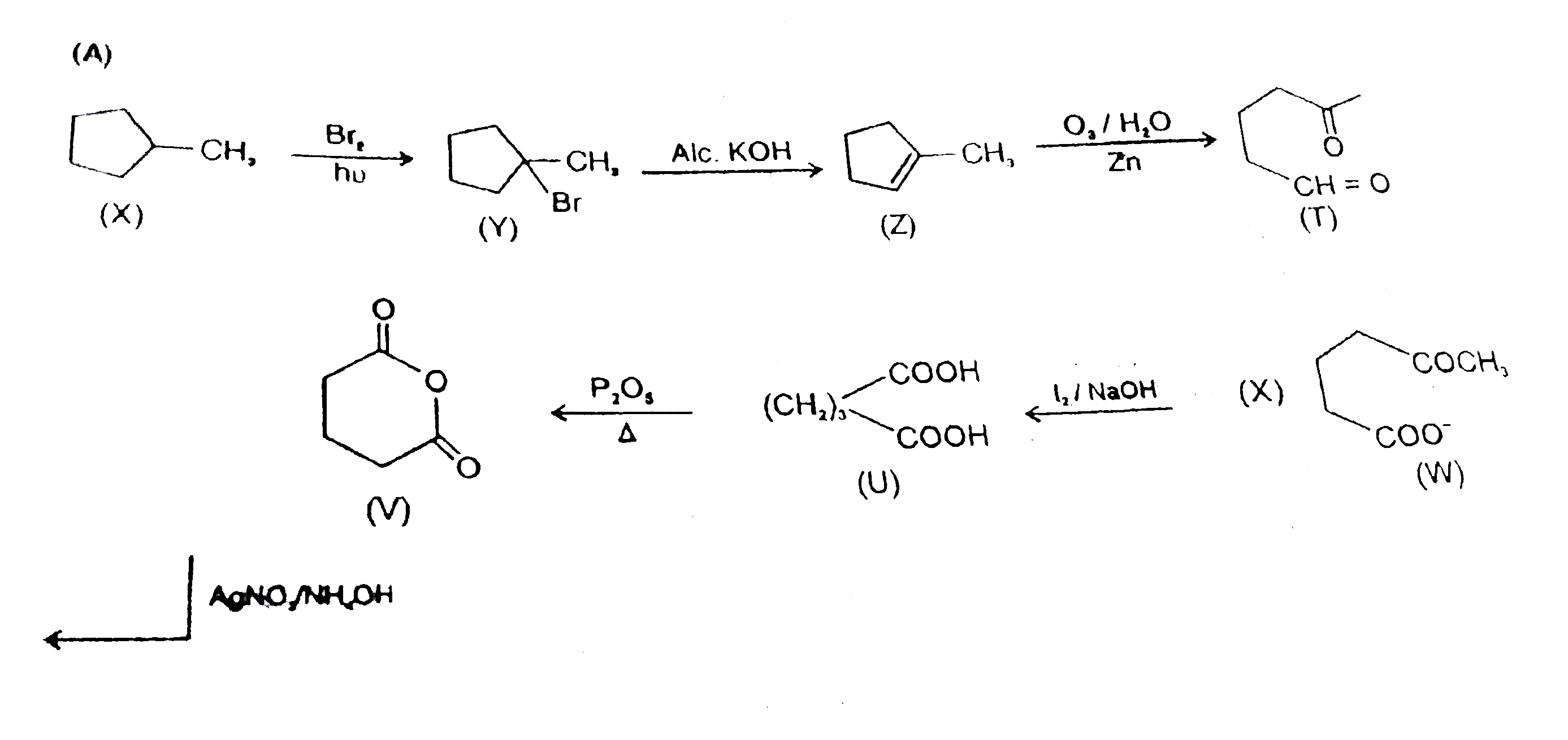
|
|
| 88960. |
A hydrocarbon (X) of the formula C_6H_12 does not react withbromine water but reacts with bromine in presence of light,forming compound (Y).Compound (Y) on treatment with Alc. KOH gives compound (Z) which on ozonolysis gives (T) reduces Tollens reagent which gives compound (W) after acidification . (W) gives iodoform test and after acidification produce compound (U) which when heated with P_2O_5 forms a cyclic anhydride (V). Compound W is |
|
Answer» `COOH-(CH_2)_2-COOH` |
|
| 88961. |
A hydrocarbon (X) of the formula C_6H_12 does not react withbromine water but reacts with bromine in presence of light,forming compound (Y).Compound (Y) on treatment with Alc. KOH gives compound (Z) which on ozonolysis gives (T) reduces Tollens reagent which gives compound (W) after acidification . (W) gives iodoform test and after acidification produce compound (U) which when heated with P_2O_5 forms a cyclic anhydride (V). CompoundV is |
|
Answer»
|
|
| 88962. |
A liquid aerosol is a colloidal system of: |
|
Answer» A LIQUID dispersedin a solid |
|
| 88963. |
A hydrocarbon X adds on one mole of hydrogen to give another hydrocarbon and decolourises bromine water. X reacts with KMnO_4in presence of acid to give two moles of the same carboxylic acid. The structure of Xis |
|
Answer» `CH_2=CH-CH_2CH_2CH_3` |
|
| 88964. |
(A) Liquid ammonia is used for refrigeration (R ) The moisture in ammonia is removed by using CaO |
|
Answer» Both (A) and (R ) are TRUE and (R ) is the correct explanation of (A) |
|
| 88965. |
A hydrocarbon X decolourises bromine water and with HI it forms isopropyl iodide X is : |
|
Answer» Propyne |
|
| 88966. |
A hydrocarbon with molecular formula C_5H_12on mono chlorination in presence of light gives four compounds A,B,C,D. A is optically inactive and dehydrohalgenation gives E( major) which on ozonolysis gives acetone and acetaldehyde. B is optically active gives on dehydrohalogenation E also gives E as the major product. Further C is optically active while D is optically inactive. Allcompounds A,B,C,D on reduction give 2-methyl butane.The structure B is |
|
Answer» `(CH_3)_2CHCHClCH_3` 
|
|
| 88967. |
A hydrocarbon with molecular formula C_(8)H_(18) gives only one monochloro derivative. It can be : |
|
Answer» n-octane |
|
| 88968. |
A hydrocarbon with molecular formula C_5H_12on mono chlorination in presence of light gives four compounds A,B,C,D. A is optically inactive and dehydrohalgenation gives E( major) which on ozonolysis gives acetone and acetaldehyde. B is optically active gives on dehydrohalogenation E also gives E as the major product. Further C is optically active while D is optically inactive. Allcompounds A,B,C,D on reduction give 2-methyl butane.Which of the following is likely structure of C |
|
Answer» `ClCH_2CH(CH_3)CH_2CH_3` 
|
|
| 88969. |
A hydrocarbon with molecular formula C_5H_12on mono chlorination in presence of light gives four compounds A,B,C,D. A is optically inactive and dehydrohalgenation gives E( major) which on ozonolysis gives acetone and acetaldehyde. B is optically active gives on dehydrohalogenation E also gives E as the major product. Further C is optically active while D is optically inactive. Allcompounds A,B,C,D on reduction give 2-methyl butane.Which of the following is the correct structure of A |
|
Answer» `ClCH_2CH(CH_3)CH_2CH_3` 
|
|
| 88970. |
AhydrocarbonwithformulaC_(8)H_(12)givesonemonochloro derivative, thehydrocarbonis: |
|
Answer» N- OCTANE |
|
| 88971. |
A hydrocarbon reacts with hypochlorous acid to give 2-chloroethanol. The hydrocarbon is: |
|
Answer» Methane |
|
| 88972. |
A hydrocarbon reacts with hypochlorous acid to give 1-chloro-2-hydroxyethane. The hydrocarbon is |
|
Answer» Ethylene |
|
| 88973. |
A hydrocarbon reacts with hypochlorous acid to give 1-chlor-2-hydroxy ethane. The hydrocabon is |
|
Answer» METHANE |
|
| 88974. |
A hydrocarbon (R) has six membered ring in which there is no unsaturation.Two alkyl group are attached to the ring adjacent to each other.One group has 3 carbon atoms with branching at 1^(st) carbon and another has 4 carbon atoms.The larger alkyl group has main chain of three carbon atoms of which second carbon is substituted. Correct IUPAC name of compound (R) is |
|
Answer» 1-(1-Methylethyl)-2-(1-methylpropyl)cyclohexane 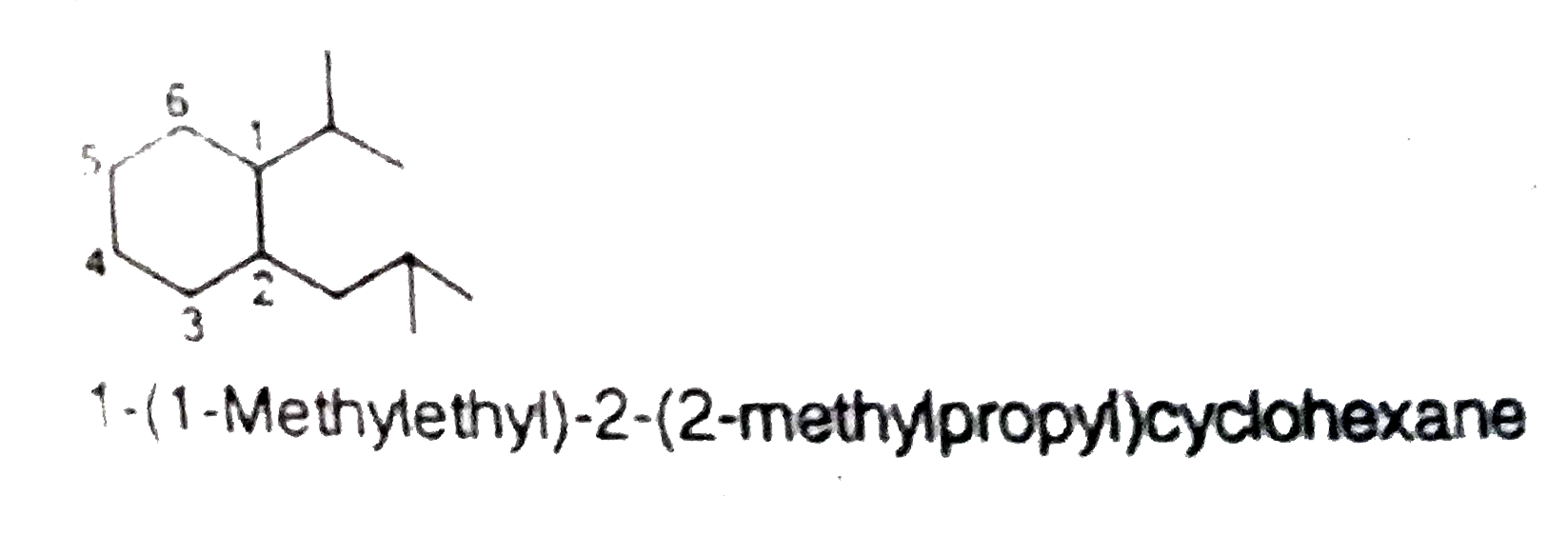
|
|
| 88975. |
A hydrocarbon 'P' having molecular formula C_(8)H_(10) can form only three monochloroderivative. 'P' on oxidation with KMnO_(4) yields a compound, which on heating with aq. NH_(3) yields 'Q'. 'Q' on treatment with NaOH followed by NaOCl yields a salt which on acidification yields with (NaNO_(2)+HCl) and then with base to give dipolar ion 'S' which readily losses two gases two give an intermediate 'T' is finally converted into hydrocarbon 'U' on dimerisation. degree of unsaturation in the hydrocarbon 'U' will be: |
|
Answer» |
|
| 88976. |
A liquid (A) is treated with Na_(2) CO_(3) solution. A mixture of two salts (B ) and ( C ) are product in the solution. The mixture on acidification with sulphuric acid and distillation produces the liquid (A ) again. Which of the following Halogen molecule can have Reddish brown colour ? |
|
Answer» `F_(2)` `underset("(X)")(CaOCl_(2))+ 2KI + 2HCl RARR CaCl_(2) + 2KCl + H_(2) O +I_(2)` `CaOCl_(2) + 2KI + 2HCl rarr CaCl_(2) + 2KCl + H_(2) O + I_(2) , CaOCl_(2) + CO_(2) rarr CaCO_(3) + Cl_(2)` |
|
| 88977. |
A hydrocarbon of molecular mass of 72 g mol^(-1) gives a single monochloro derivative and two dichloro derivatives on photochlorination. Give the structures of the hydrocarbon. |
|
Answer» Solution :The hydrocarbon having molecular mass of 72 g `mol^(-1)` must be `C_(5)H_(12)`. Since on photochlorination, it gives a single monochloro derivative, THEREFORE, all the twelve HYDROGENS in this hydrocarbon are equivalent. Thus, the hydrocarbon must be neopentane or 2,2-dimethylpropane, it forms only one monochloro derivative and two dichloro derivatives as shown below: `underset("2,2-Dimethylpropane (All the 12 H's are equivalent)")(CH_(3)-underset(CH_(3))underset(|)overset(CH_(3))overset(|)(C)-CH_(3))""underset("1-Chloro-2,2-dimethylpropane (Monochloro derivative)")(CH_(3)-underset(CH_(3))underset(|)overset(CH_(3))overset(|)(C)-CH_(2)Cl)""underset("1,3-Dichloro-2,2-dimethylpropane (Dichloro derivative)")(CH_(3)-underset(CH_(3))underset(|)overset(CH_(2)Cl)overset(|)(C)-CH_(2)Cl)""underset("1,1-Dichloro-2,2-dimethylpropane (Dichloro derivative)")(CH_(3)-underset(CH_(3))underset(|)overset(CH_(3))overset(|)(C)-CHCl_(2))`. |
|
| 88978. |
A liquid (A) is treated with Na_(2) CO_(3) solution. A mixture of two salts (B ) and ( C ) are product in the solution. The mixture on acidification with sulphuric acid and distillation produces the liquid (A ) again.The mixture of salt's are |
|
Answer» NABR, NaCl |
|
| 88979. |
A liquid (A) is treated with Na_(2) CO_(3) solution. A mixture of two salts (B ) and ( C ) are product in the solution. The mixture on acidification with sulphuric acid and distillation produces the liquid (A ) again.The liquid compound 'A' is |
|
Answer» `H_(2)O` |
|
| 88980. |
A hydrocarbon of molecular mass 72 g mol^(-1) gives a single monochloro derivative and two dichloro derivatives on photo chlorination. Give the structure of the hydrocarbon. |
|
Answer» Solution :`C_(5)H_(12)`, Pentane has MOLECULAR mass 72 g `MOL^(-1)`. Neo-pentane YIELD monochlorinated product because all 1,2-hydrogen are equivalent. `CH_(3)-overset(CH_(3))overset("|")underset(CH_(3))underset("|")("C")-CH_(3) overset(Cl_(2))underset(" Light ")rarr CH_(3)-overset(CH_(3))overset("|")underset(CH_(3))underset("|")("C")-CH_(2)Cl` Dichloro derivatives : `underset((i))(CH_(3)-overset(CH_(3))overset("|")underset(CH_(3))underset("|")("C ")-CHCl_(2))` `CH_(3)-overset(CH_(2)-Cl"")overset("|")underset(CH_(2)-Cl" ")underset("|")(C-CH_(3))` |
|
| 88981. |
A hydrocarbon of formula C_6H_10 absorbs only one molecule of H_2 upon catalytic hydrogenation. Upon ozonolysis, the hydrocarbon yields O=oversetoversetH|C-CH_2-CH_2-CH_2-CH_2-oversetoversetH|C=O The hydrocarbon is |
|
Answer» CYCLOHEXANE 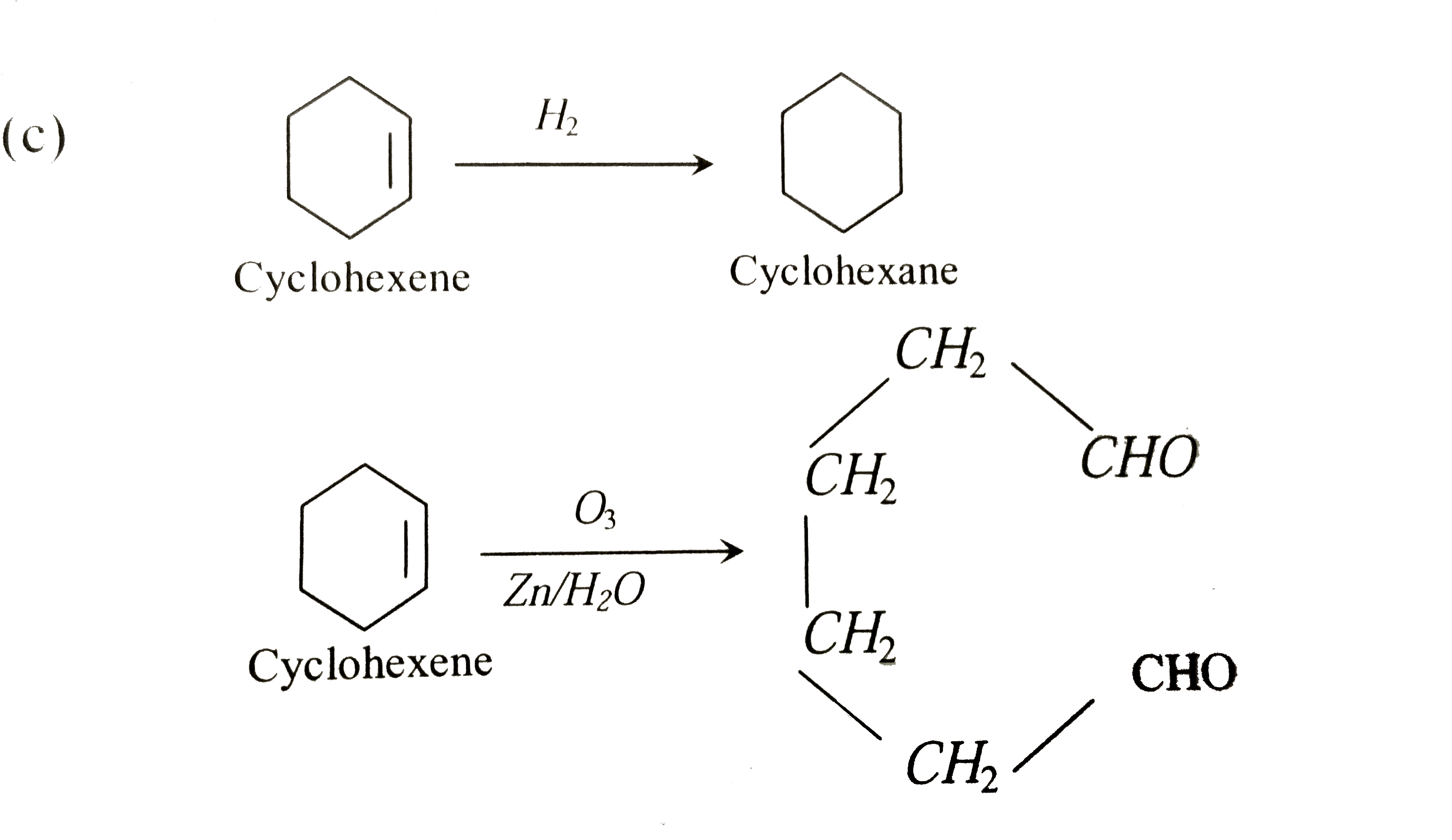
|
|
| 88982. |
A hydrocarbon of formula C_(6)H_(8) absorbs two mole of H_(2) upon hydrogenation. On ozonolysis, it yields Propanedial. What is hydrocarbon ? |
Answer» 
|
|
| 88983. |
A liqud mixture of two volatile liquids has composition corresponding to point P in the temperature vs composition graph and is subjected to distillation from the composition P. Which of the following statements is incorrect? |
|
Answer» The composition of distillate will be different |
|
| 88984. |
A hydrocarbon of formula C_(10)H_(16) absorbs only one mole of H_(2) upon hydrogenation. On ozonolysis, it yields 1, 6-Cyclodecanedione. What is the structure of the hydrocarbon ? |
Answer» 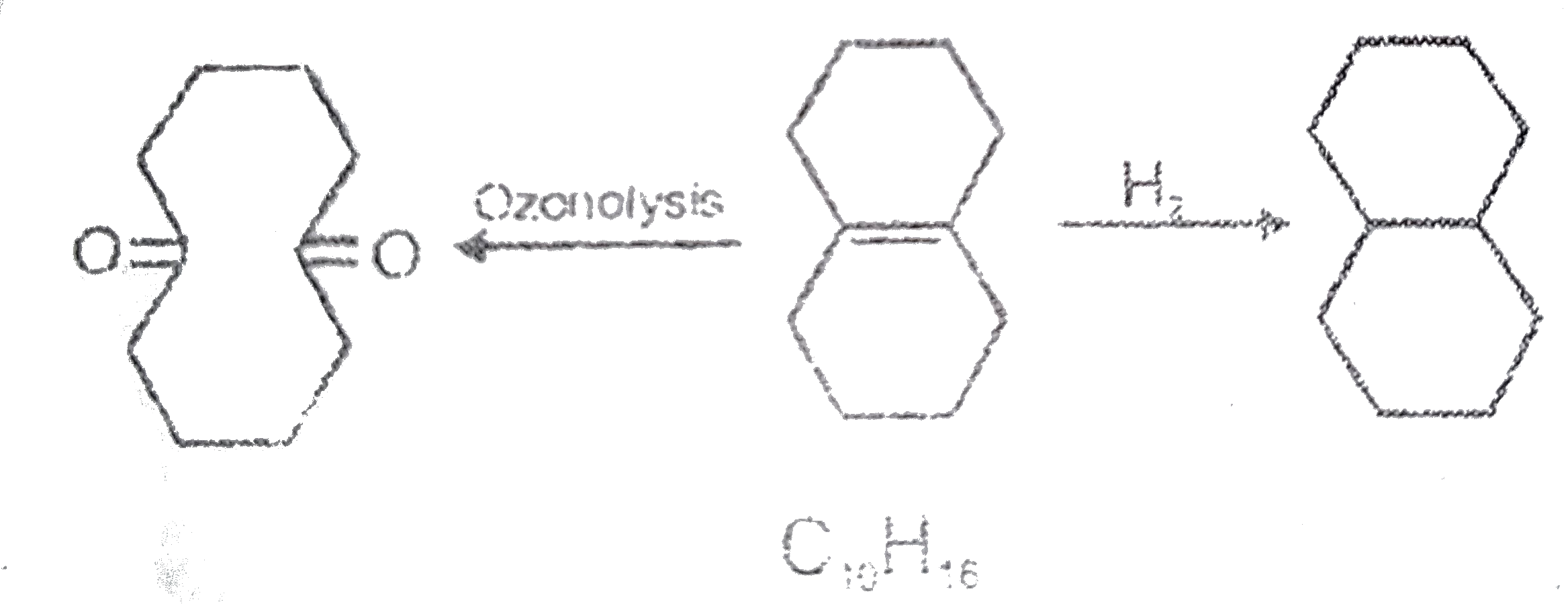
|
|
| 88985. |
A linear product of phenol and formaldehyde is used |
|
Answer» in PAINTS |
|
| 88986. |
A hydrocarbon is composed of 75% carbon. The empirical formula of the compound is |
|
Answer» `CH_2` Hydrogen = 100 - 75 = 25%  `THEREFORE ` EMPRICAL FORMULA ` = CH_4` |
|
| 88987. |
A hydrocarbon K adds one mole of hydrogen in presence of platinum catalyst to form n-hexane. When K is oxidised vigorously with KMnO_4 a single carboxylic acid is isolated and no gas evolved.The correct stablement about 'K' is |
|
Answer» It is a chiral compound 
|
|
| 88988. |
A linear molecule is: |
|
Answer» `Cl_2O` |
|
| 88989. |
A linear chain compound 'A' (C_(5)H_(10)O_(2)) gives brisk effervescence of CO_(2) when treated with saturated aqueous NaHCO_(3) solution. It reacts with chlorine gas in the presence of catalytic amount of red phosphorous to givecompound 'B' . Identify compound 'A' and 'B' . Identify the chiral isomer of compound 'A'/ |
|
Answer» Pentanoic ACID , 2-chloropentanoic acid, 2-methylbutanoic acid |
|
| 88990. |
A hydrocarbon has the formula C_3H_4 To fine out whether it contains two double bond or triple bond, the following test is performed: |
|
Answer» PASSED through AMMONIACAL `AgNO_3` |
|
| 88991. |
A hydrocarbon has the molar mass 86. The number of chain isomers possible for the compound is : |
|
Answer» Five |
|
| 88992. |
A (Light pink colour complex) underset(Delta)overset(Pb_(2)O//dil." "HNO_(2)) to HMnO_(4) overset(H_(2)S //H^(+)) to A (Light pink colour complex). Calculate CFSE value in light pink colour complex. |
|
Answer» `Mn^(2+)(3d^(5))` in `[Mn(H_(2)O)_(6)]^(+ +),Delta_(0) LT P`  CFSE of pink colour complex `=3xx(-(2)/(5)Delta_(0))+2xx[(3)/(5)Delta_(0)]=0` |
|
| 88993. |
A hydrocarbon has density 1.25 gL^(-1)at STP . The hydrocarbonis |
|
Answer» `C_(2)H_(4)` `22.4 L` of hydrocarbon at STP weigh `= 1.25 xx 22.4 = 5/4 xx 22.4 = 28.0 g mol^(-1)` Hydrocarbon will be `C_(2)H_(4) = 2xx 12 + 4 = 28 g mol^(-1)` (B) , (c ) and (d) are not possible. |
|
| 88994. |
A lighting flash through air may result in the formation of : |
|
Answer» nitrogen pentaoxide |
|
| 88995. |
A hydrocarbon contains 91.3% carbon by mass. Find the empirical formula of hydrocarbon? |
|
Answer» `CH` |
|
| 88996. |
A light greenish coloured salt was soluble in water. On passing H_2 S into the solution, a black ppt. was obtained which dissolved readily in HCl. The metal ion present is |
|
Answer» `Co^(2+)` `FeS(s)+2HCl(aq) to FeCl_(2)(aq)+H_(2)S(g)` |
|
| 88997. |
A hydrocarbon contains 10.5 g of carbon per gram of hydrogen. 1 L of vapour of the hydrocarbon at 127^(@)C and 1 atm pressure weighs 2.8 g. Find the molecular formula of the hydrocarbon. |
|
Answer» <P> Solution :Volume at NTP`= (p_(1)V_(1))/(T_(1)) xx (T_(2))/(P_(2))``=(1 xx 1)/(400) xx (273)/(1) = (273)/(400)` litre. `because (273)/(400)` litre weighs 2.8g at NTP `therefore` 22.4 litres (1 mole) weights `=(2.8 xx 400)/(273) xx 22.4g` =91.89g `~~92g` `therefore` molecular weight of the HYDROCARBON =92 `therefore{(,"Weight","Mole",),(C,10.5g,10.5//12,=0.875),(H,1g,1//1,=1):}` or `C:H= 0.875:1` `=0.875 xx 8: 1 xx` `=7: 8` Thus empirical formula is `C_(7)H_(8)` Now empirical formula weight =92= molecular weight Hence molecular formula is also `C_(7)H_(8)` |
|
| 88998. |
A light greenish coloured salt was soluble in water. On passing H_(2)S into the solution a black precipiate was obatined which dissolve readily in HCl. The metal ion present is |
|
Answer» `CO^(+2)` |
|
| 88999. |
A light green coloured salt was soluble in water. On passing H_(2)S into the solution a black precipitate was obtained which dissolved readily in HC. The metal ion present is |
|
Answer» `Co^(2+)` |
|
| 89000. |
A light green salt soluble in water gives blackprecipitate onpassing H_(2)S which dissolves readily in HCI .The metalion present is |
|
Answer» `Co^(2+)` |
|